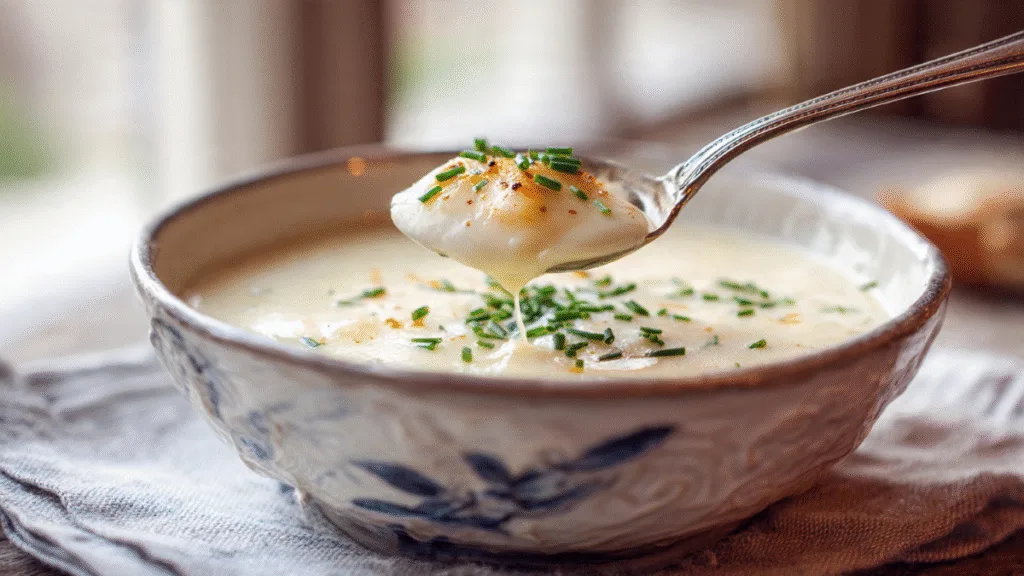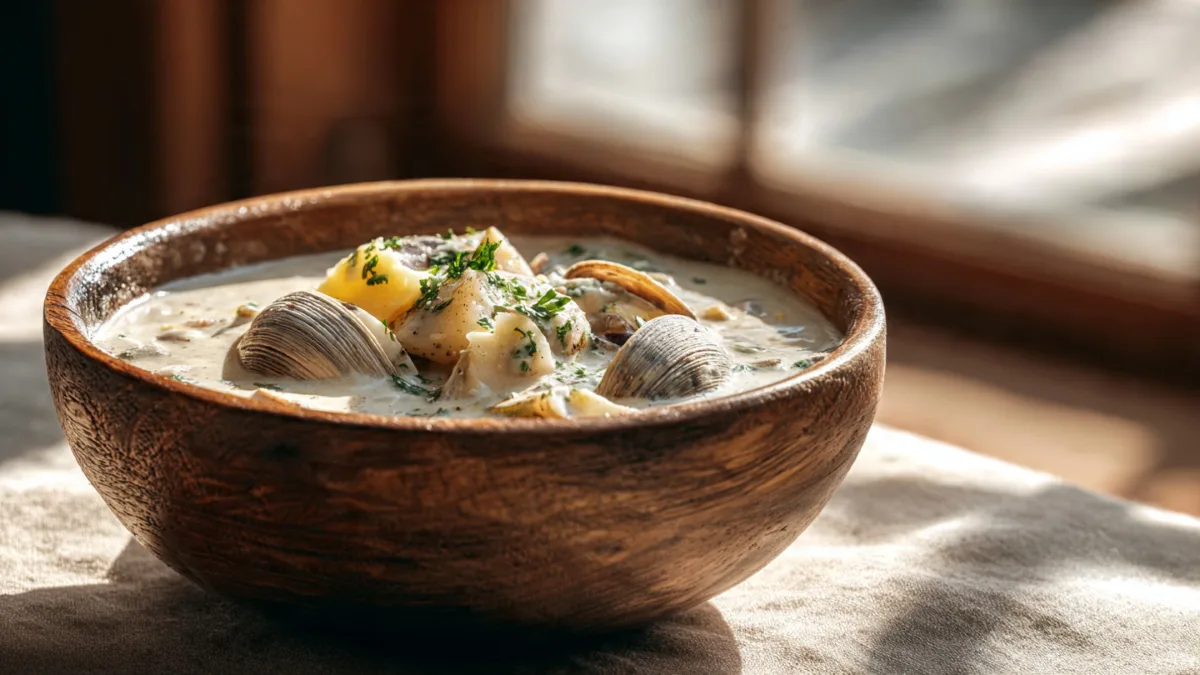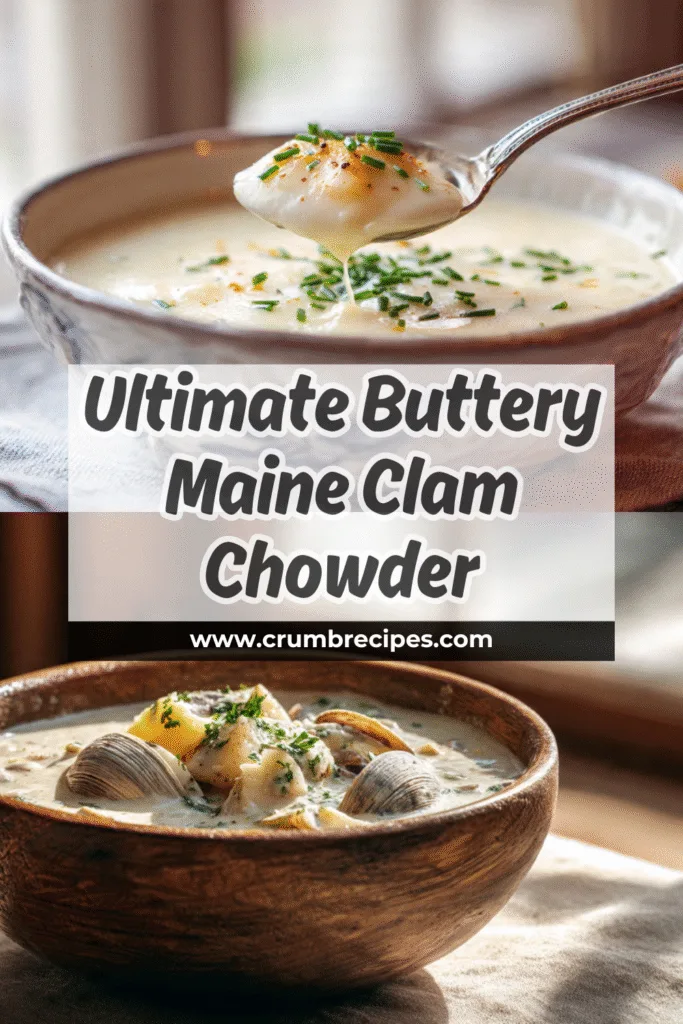Alright, let’s talk about something near and dear to my heart: a truly magnificent bowl of clam chowder. I’m not talking about that thick, gloopy stuff you get from a can that a spoon could stand up in. No, I’m talking about the soul-warming, brothy, buttery, and milky elixir that is Maine Style Clam Chowder. If you’ve never had it, you’re in for a treat. And if you have, then you already know the profound comfort it brings.
For years, I thought my family’s clam chowder was just our own unique recipe. It’s a white chowder, but thin and brothy, not heavy and thick like many you’ll find in Massachusetts. It wasn’t until I dove deeper into the culinary world that I realized we were making a classic Maine Clam Chowder. It’s a simpler, more elegant version that lets the flavor of the clams shine. And today, I’m going to share with you how to make this delightful seafood soup.

What Makes Maine Clam Chowder Different?
So, what’s the big deal? Isn’t all New England clam chowder the same? Oh, my friend, you couldn’t be more wrong. The great chowder debate is a fierce one, especially in New England.
The Great Thickener Debate
The most defining characteristic of a traditional Maine clam chowder is that it’s made with milk and is never thickened with flour. This is a huge departure from its more common, cream-based Boston counterpart, which often uses a roux (a mix of flour and butter) to achieve its signature thickness. Mainers, in their classic, no-fuss approach to cooking, believe that a chowder should be soupy, not a stew.
This results in a chowder that is lighter, yet still incredibly rich and flavorful. It’s a buttery, milky broth that warms you from the inside out without weighing you down. Some might even call it a more “pure” clam chowder experience. IMO, they’d be right.
Clams: Soft-Shell vs. Hard-Shell
Another key difference you’ll find in Maine is the use of soft-shell clams, also known as steamers. Historically, the colder waters of Maine were more hospitable to soft-shell clams than their hard-shell cousins (quahogs), which are more common further south.
Soft-shell clams have thinner, more brittle shells and incredibly tender, sweet meat. Steaming them not only cooks the clams to perfection but also creates a heavenly, less briny clam broth that becomes the very soul of your chowder. Don’t worry if you can’t find fresh steamers; good quality canned clams and bottled clam juice will work in a pinch.
How To Make Maine Clam Chowder
Ready to create some magic in your kitchen? This recipe is straightforward and doesn’t require any fancy techniques. The key is good ingredients and a little bit of patience.
Your Cast of Characters (Ingredients)
Here’s what you’ll need to assemble your masterpiece:
- Bacon or Salt Pork: About 1/4 pound, minced. This provides a smoky, savory base.
- Butter: 2 tablespoons. Because butter makes everything better.
- Onion: 1 large, chopped.
- Potatoes: About 2 pounds of Yukon Gold or Russet potatoes, peeled and diced.
- Clam Juice: 1 quart. If you’re using fresh clams, you’ll make your own!
- Chopped Clams: 1 pound of fresh or canned clams.
- Evaporated Milk: One 12-ounce can. Do not, I repeat, do not use the low-fat version. This is key to a creamy texture without curdling.
- Whole Milk: 3 cups.
- Black Pepper: Freshly ground, to taste.
The Step-by-Step Playbook
- Build the Flavor Base: In a large soup pot or Dutch oven, melt the butter over medium heat. Add your minced salt pork or bacon and the chopped onion. Cook this slowly until the onions are soft and translucent, but not browned. We’re coaxing out the flavor, not rushing it.
- Cook the Potatoes: Add the diced potatoes to the pot, along with the clam juice. If the juice doesn’t quite cover the potatoes, add just enough water to do so. Bring this to a simmer and cook for about 15 minutes, or until the potatoes are tender.
- The Clam Drop: Once the potatoes are just about done, add your chopped clams and immediately turn off the heat. Let this mixture cool down for at least 30 minutes. This step is crucial for preventing the milk from curdling later. You can even make this chowder base a day ahead and refrigerate it.
- The Milky Way: When the chowder base is cool (below 100°F), it’s time to add the milk and evaporated milk. Turn the heat on low and gently bring the chowder up to eating temperature. Whatever you do, do not let it simmer or boil. This is the cardinal rule of Maine clam chowder. A gentle, patient warming is all it needs.
- Finishing Touches: Season with a generous amount of freshly ground black pepper and serve hot. That’s it! Resist the temptation to add a bunch of other herbs and spices. The beauty of this dish is its simplicity.
Let’s Talk Variations and Other Seafood Soups
While the classic Maine Clam Chowder is a thing of beauty, there’s always room to play in the kitchen, right?
Seafood Chowder: The More the Merrier
If you’re a true seafood lover, why stop at clams? A glorious Seafood Chowder is a fantastic way to celebrate the ocean’s bounty. You can follow a similar base recipe but add a medley of your favorite seafood.
- Fish: Chunks of firm white fish like cod, haddock, or halibut work beautifully.
- Shrimp and Scallops: Add these in the last few minutes of cooking so they don’t get tough.
- Crabmeat: A luxurious addition that adds sweetness and delicate texture.
For a creamy seafood chowder, you might want to create a light roux with flour and butter after sautéing your onions, then slowly whisk in your broth and milk. Old Bay seasoning is also a fantastic addition to a mixed seafood chowder.
The Bone Broth Boost
Want to add another layer of flavor and some serious nutritional benefits? Consider swapping out some of the clam juice or water for a high-quality Bone Broth. A chicken or fish bone broth can add a rich, savory depth to your chowder. It’s an unconventional twist, but one that can elevate your soup to new heights.
Famous Chowders and Inspirations
Ever wondered what makes some clam chowders famous? Places like Bratten’s Famous Clam Chowder or recipes from culinary personalities like Natasha’s Kitchen often have a signature touch. For instance, Natasha’s Kitchen Clam Chowder includes carrots and a hint of Tabasco and Worcestershire sauce for a little extra kick. While not traditional for a Maine chowder, it shows how versatile this soup can be.
Even a so-called Midwest Clam Chowder exists, though it’s more of a catch-all term for creamy, hearty versions found far from the coast. These often lean heavily on the thick and creamy side, sometimes using canned cream of celery soup as a base. To each their own, I suppose. But for me, the buttery, milky broth of a Maine chowder reigns supreme.
Final Thoughts and Pro Tips
Making a perfect Buttery Milky Maine Clam Chowder is all about respecting the ingredients and the process. Here are a few final thoughts to ensure your success:
- Don’t Boil the Milk! Have I said this enough? Seriously, it’s the most important rule. If you’re nervous about it, you can heat the milk separately until it’s steaming and then add it to the cooled chowder base. Or, for a foolproof method, skip the whole milk and add heavy cream at the end; it’s much more stable.
- Let it Rest: Like many soups and stews, clam chowder is often even better the next day. Letting it sit allows the flavors to meld and deepen.
- What to Serve With It: Keep it simple. Oyster crackers are a must, and a side of Yankee cornbread or johnnycakes is traditional and delicious.
So there you have it. Everything you need to know to create a truly spectacular bowl of Maine Clam Chowder. It’s more than just a soup; it’s a taste of coastal tradition, a comforting hug in a bowl, and, IMO, the best darn clam chowder you’ll ever have. Now go on, give it a try. You can thank me later.

Buttery Milky Maine Clam Chowder
Ingredients
Method
- In a large pot or Dutch oven, cook the bacon over medium heat until crisp. Remove with a slotted spoon and set aside, leaving about 1 tablespoon of fat in the pot.
- Add butter and chopped onion to the pot. Sauté for 4–5 minutes until soft and translucent but not browned.
- Add diced potatoes and pour in the clam juice (including reserved clam liquid). Bring to a gentle boil, then reduce heat and simmer for 10–12 minutes until potatoes are tender.
- Stir in the milk and half-and-half (if using). Warm gently over low heat — do not let it boil to prevent curdling.
- Add the chopped clams and cook for 3–5 minutes, just until heated through. Season with salt and black pepper to taste.
- Remove from heat and stir in an extra tablespoon of butter for a rich, silky finish.
- Ladle into bowls, top with crisp bacon and fresh parsley, and serve hot with oyster crackers or crusty bread.
Notes


